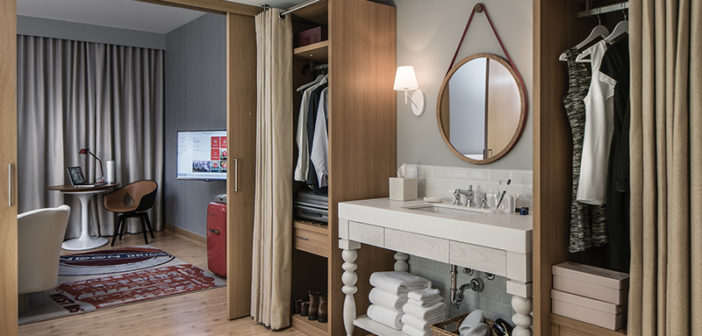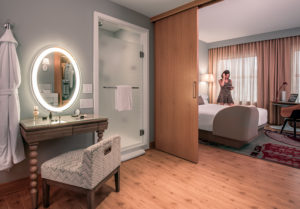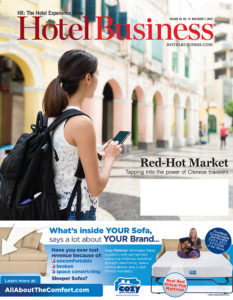CHICAGO—When Virgin Hotels Chicago opened, it did so with the female traveler in mind. It’s something that Sir Richard Branson has touted as a core strength of the brand since the first property in Chicago debuted, and something that Diego Lowenstein, CEO of Lionstone Development, which partnered with Virgin Group on ownership of the property, said will continue to evolve with future hotels.
It’s easy to see why. According to a study done by George Washington University School of Business, nearly two-thirds of travelers today are women, making them an important target demographic for both business and leisure travel. Lowenstein, who had input on the renovation decisions of The Old Dearborn Bank Building (where the hotel is located), loan transactions and is currently negotiating deals for a Virgin hotel in Miami, noted, “All brands understand the importance of the female traveler, but we were probably the first to truly push it in a stronger way. Every reputable developer should be thinking about this: There is a distinction between a female and a male traveler and it’s an obvious position to be able to cater wisely to that woman.”
So, how was this female focus accomplished? Subtly. “You’ve got to get it right,” said Lowenstein. “We did it in a very tasteful way. Obviously, the rooms are meant to be for all demographics. It’s not in your face, where you go in and it feels like this is designed for women only—that’s not the case. There’s a fine balance of building those amenities into the room and going to the extreme to where you potentially alienate a different kind of demographic.”
So, for instance, this means spacious glass-topped silver vanity tables with upholstered chairs and backlit magnifying mirrors, sliding shoe racks, extra lingerie holders in closets and professional hair dryers. The bathroom, dressing area and room area are all separated, and the showers—which were designed to be oversized—feature a step-up bench so that women can attend to their shaving needs. “From a room-design standpoint, we put features that feel more at home in a residential type of offering or in a luxury hotel offering and we brought it to our standard room layout,” said Lowenstein. He added that some features offer comfort, while others (like the bench, and hair dryers “that actually work”) give women the ability to streamline the getting-ready process so they can devote more time to the purpose of their trip, be it business or vacation. “It’s the little details that are provided to the woman traveler that make it more friendly,” he said.
This goes for public areas as well. “A lot of women travel by themselves,” Lowenstein pointed out. “Security is paramount, and lighting and security are tied at the hip. Proper lighting throughout the hotel, not only at the room level, but accessibility to that room is significant. Our corridors, unlike many traditional boutique hotels that tend to be very dark, are friendly, very light and you can actually see yourself and other people. That was an important feature of the public domain of the hotel.”
Highlighting that a more nuanced approach is best, Lowenstein said that the idea of a women-only floor was bandied about, but ultimately rejected. “Frankly, that was not well-received. Women don’t particularly want to be offered something that feels like it’s actually discriminating against them and have something that’s exclusive to them,” he said, noting that this concept has been done in other parts of the world “But we found in the U.S., the typical woman would not go for that.”
The measures, said Lowenstein, also have an added benefit for other demographics beyond women. For instance, the separation of space can be good for travelers—colleagues or friends—who are sharing a room but who don’t necessarily want too much personal intimacy. “Particularly younger demographics, like millennials, they tend to travel together,” he said. “It provides a sense of privacy that most other hotel products don’t allow because they have open bathrooms or a very small space. It’s an interesting proposition here.”
Feedback has been positive. “I was surprised how well-received it was, not only from feedback at the property level but also on social media,” said Lowenstein. “When we launched the product we had great reviews as it relates to that, hitting on those points for the female traveler. For me, it was a better validation of the concept than we thought we would get… It’s evident that if you’re a woman, you go in and say ‘Wow, these guys thought about it.’”
Along with Branson, Lowenstein is looking to expand the brand’s footprint. “As we open more hotels, we will continue to focus on the female traveler because it’s such an important part of the equation here,” said Lowenstein. “The numbers show the strength of women traveling today, both from a corporate and a leisure standpoint, and how significant a share of the decision making that is being done today by women, particularly in the U.S. as it relates to corporate travel for both large- and medium-sized firms. It’s evident that the female touch and the female decision is critical in our industry, and as we looked to design the product, both from a physical and a service standpoint, we particularly paid attention and generated certain touchpoints that would cater specifically to women. That’s evident in our Chicago hotel, and it will be evident in every single hotel that we open in the coming years under the Virgin flag.” HB



